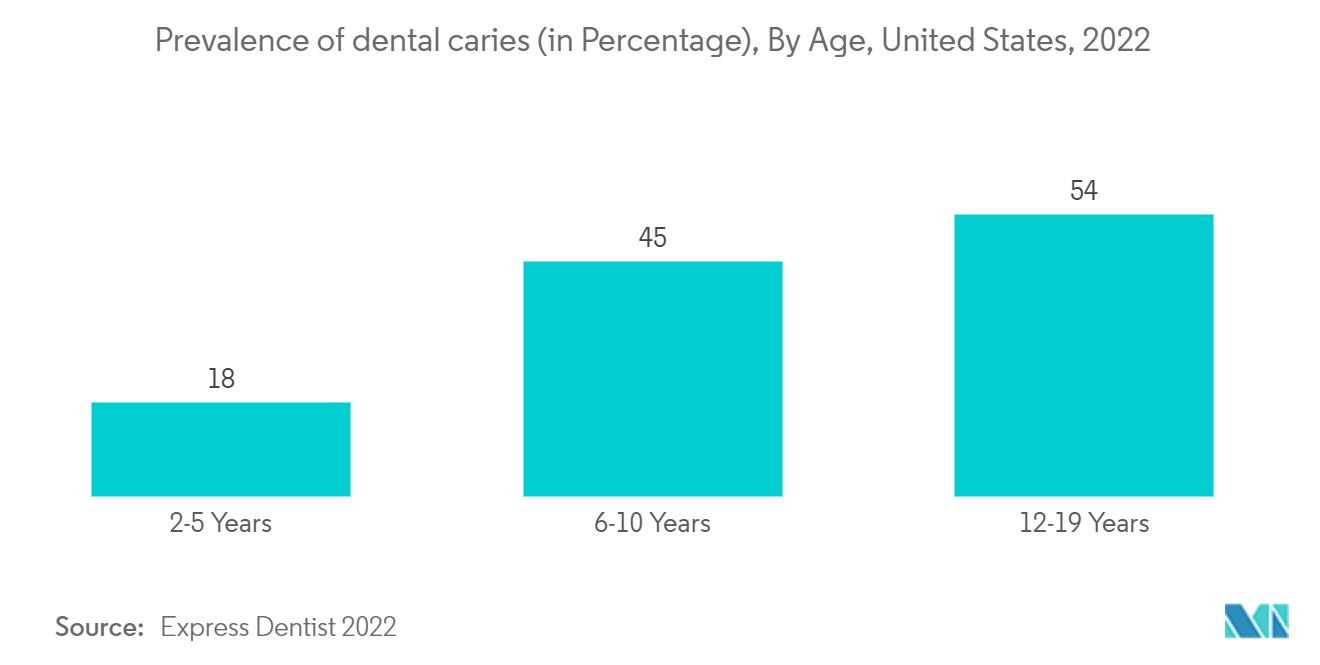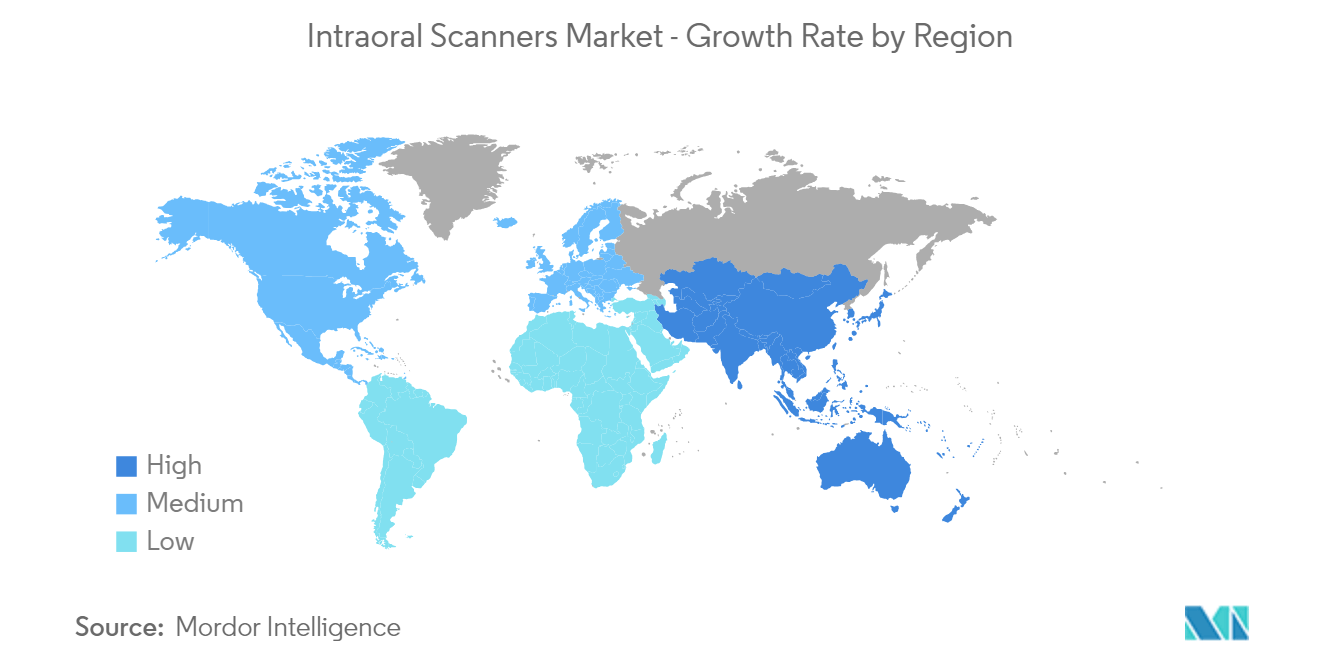Market Trends of Intraoral Scanners Industry
Standalone Devices Segment is Expected to Witness Strong Growth in The Coming Years
Standalone devices are expected to witness promising growth due to the improved workflow of dental professionals in oral scanning procedures and improved outputs of these devices. Furthermore, due to the introduction of miniature portable intraoral scanners in the market, incorporating the side-oriented tip in small intraoral scanners has made buccal surface scans much more accessible, quicker, and more effective. Thus, the enhanced output offered by these devices is expected to fuel the segment's growth.
Oral illnesses affect people throughout their lives, causing pain, suffering, disfigurement, and sometimes death. They are a significant health burden for many nations. For instance, according to the data published by the National Institute of Dental and Craniofacial Research in April 2022, it has been observed that tooth decay affects about 90% of adults aged 20 to 64 years, and gum diseases affect almost 50% of adults aged 45 to 64 years, annually, in the United States. Thus, the rising dental diseases are likely to boost the demand for intraoral scanners for effective disease detection.
Furthermore, intraoral scanners have become increasingly popular in the dental impression market due to their ability to reduce chairside time and improve the accuracy of final restorations. While traditional impression materials are still widely used, the adoption of intraoral scanners represents a significant shift toward digital dentistry, offering precision, patient comfort, and the overall quality of dental care. As technology continues to advance, the role of intraoral scanners is likely to expand further, influencing the future landscape of dental impressions in dentistry. For instance, in September 2022, 3Shape launched a wireless intraoral scanner called TRIOS 5, which features ScanAssist intelligent alignment technology that delivers the highest imaging performance and infection control standard. According to the company, TRIOS 5 Wireless features an FDA-cleared, closed autoclavable scanner tip protected by scratch-free sapphire glass to define a new level of hygiene and includes ultra-thin, snug, and near-invisible single-use sleeves to cover the scanner body and minimize the risk for cross-contamination.
Therefore, the studied sub-segment is anticipated to rise over the forecast period due to the benefits associated with scanners, the rising demand for scanners, and the growing focus by significant players on developing and marketing improved scanners.

North America is Expected to Hold a Significant Market Share During the Forecast Period
North America is expected to register significant growth over the forecast period. A rise in the geriatric population susceptible to oral disorders, an increasing number of patients suffering from dental problems, and advanced healthcare infrastructure are the key factors propelling the market growth.
The increasing tooth decay in the geriatric population can drive the demand for intraoral scanners in the United States for several reasons. Firstly, as the aging population grows, there is a higher likelihood of oral health issues, including tooth decay and loss, necessitating dental interventions. For instance, as per the April 2022 update by the National Institutes of Health (NIH), about 9 out of 10 adults aged 20 to 64 experienced tooth decay in the United States over the past 2 years. Similarly, according to the 2022 statistics published by the United Nations Population Fund, in Canada, about 19% of the population is aged 65 years and above in 2022. Thus, the growing aging population is expected to increase the burden of dental diseases and is likely to contribute to market growth. Thus, growing tooth decay in the aging population is expected to increase the demand for intraoral scanners to detect the disease and contribute to market growth over the forecast period.
Additionally, as the United States healthcare system develops and dental problems become more well-known, more people are anticipated to visit dentists and hospitals, which will support the expansion of the intraoral scanner market in the region. For instance, in October 2022, the American Diabetes Association (ADA) announced a collaborative Oral Health campaign with Pacific Dental Services (PDS). The campaign aims to increase awareness of periodontal disease (gum disease) and how oral health providers can assist patients in preventing and managing this chronic health condition. Thus, such initiatives are likely to increase awareness about dental health in the country, which is likely to augment the number of dental visits and ultimately contribute to the market growth.
Moreover, favorable reimbursement policies for dental procedures are expected to contribute to the market’s growth. For instance, in September 2022. the government of Canada introduced the Canadian Dental Benefit, an immediate measure to provide low-income families (under USD 90,000 annual family income) in Canada with USD 260 – USD 650 of coverage per child under 12 years. This benefit is retroactive to cover dental expenses from October 1, 2022, and is only available for two reporting periods.
Due to technological advancements, the key market players in the country are launching new and advanced scanners, which are also expected to have a significant impact on the growth of the studied market in the region. For instance, in April 2023, Ori Dental launched the Ori Intraoral Scanner as a modern alternative to traditional dental Polyvinyl Siloxane (PVS) impressions. This intraoral dental scanner is made to be faster, lighter, more accurate, and less expensive than traditional PVS dental impressions.
Therefore, the rising geriatric population, which is more prone to dental diseases, government support initiatives, and reimbursements are anticipated to fuel the intraoral scanners market growth in the region.


